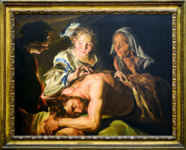François Lemoyne (1688 – 4 June 1737)
At the height of Impressionism, Pierre Renoir was the target of negative comments concerning his paintings of voluptuous nudes. Monet famously quipped (to an effect): “
You must forgive our dear Renoir, for he’s been seen again in the company of Parisian women.”
Monet’s comment had a double-meaning. “
Parisian Women” could certainly refer to attractive women of less-than-upstanding moral character… even prostitutes. At the same time, it undoubtedly was intended as a slightly disproving witticism aimed at Renoir’s known admiration for the salacious nudes paintings by Rococo masters such as Fragonard and Boucher to be found in the Louvre.
Like Renoir, I’m not ashamed of having been seen with “Parisian ladies”… I don’t dislike the Rococo.
I first stumbled upon François Lemoyne through his marvelous painting of
Venus & Adonis:
In many ways I find this painting to be a brilliant heir to the works of Rubens. The off-balance compositional thrust of the painting is especially dramatic and reinforces the narrative as Venus desperately struggles to hold Adonis back from his fatal hunt. The sweeping curve of Venus’ body is especially delicious. For all the voluptuous sensuality there is nothing “vulgar” about this erotic mythological scene. Lemoyne’s painting has an elegant lightness suggestive of Tiepolo… and a sensuous innocence that suggests the underrated Renaissance master, Correggio:
Lemoyne made a number of other marvelous paintings, of which I find the
Bather...
Adam and Eve…
... and
Hercules and Omphale...
...
to be the most endearing.
Hercules and Omphale immediately reminds me of Théophile Gautier’s erotic rococo tale,
Omphale, in which a young romantic lad is seduced by the goddess who comes forth to life like Pygmalion… from a tapestry hung in his bedroom.
Lemoyne is clearly not the most original artist… and many of his compositions and figures seem to be heavily indebted to the works of predecessors whose work he must have known: Tiepolo, Veronese, Correggio, and certainly Rubens.
His latter paintings… with overly-polished elements that verge on Neo-Classicism leave me rather cold, nevertheless, at his finest Lemoyne produced a number of truly delicious Rococo bon-bons.








